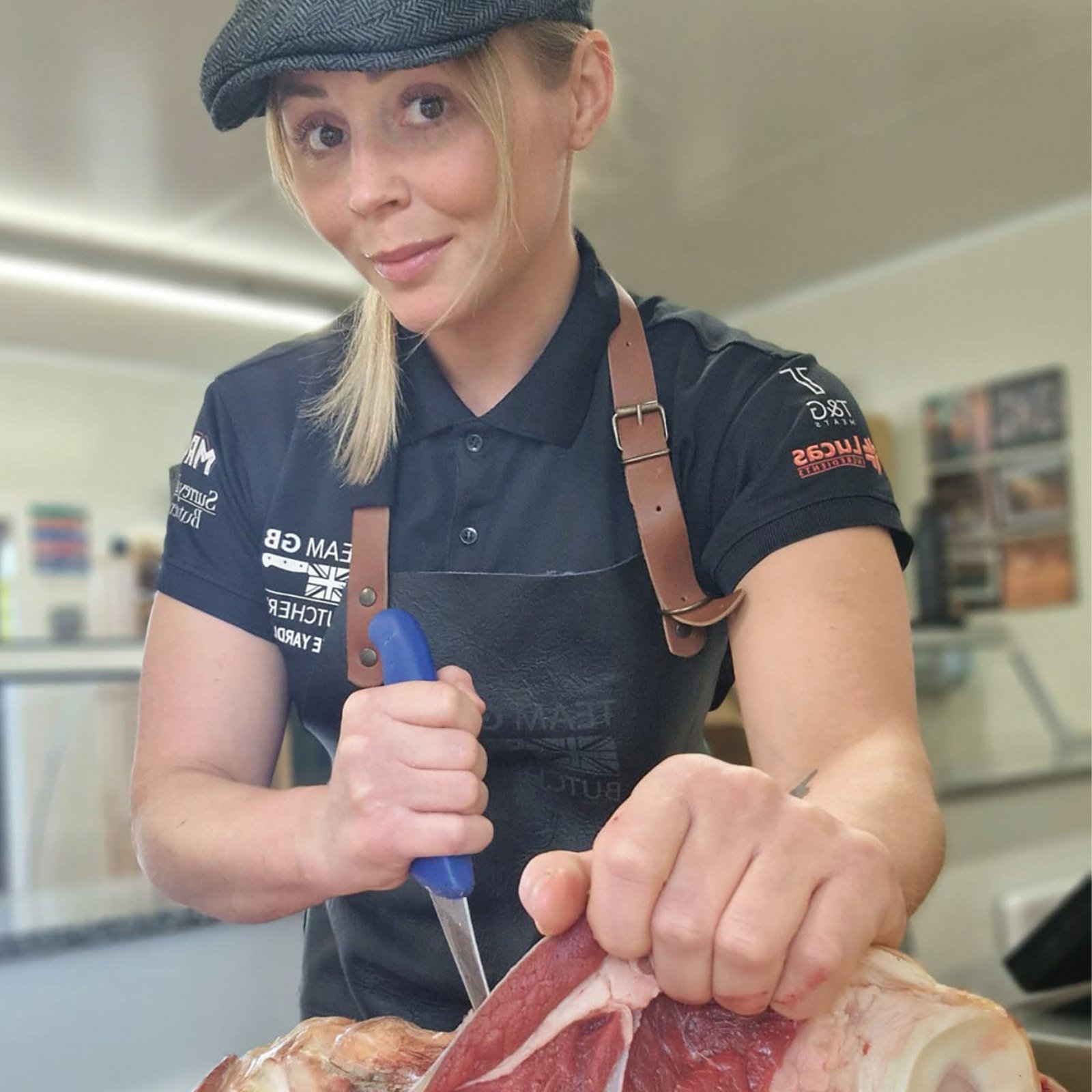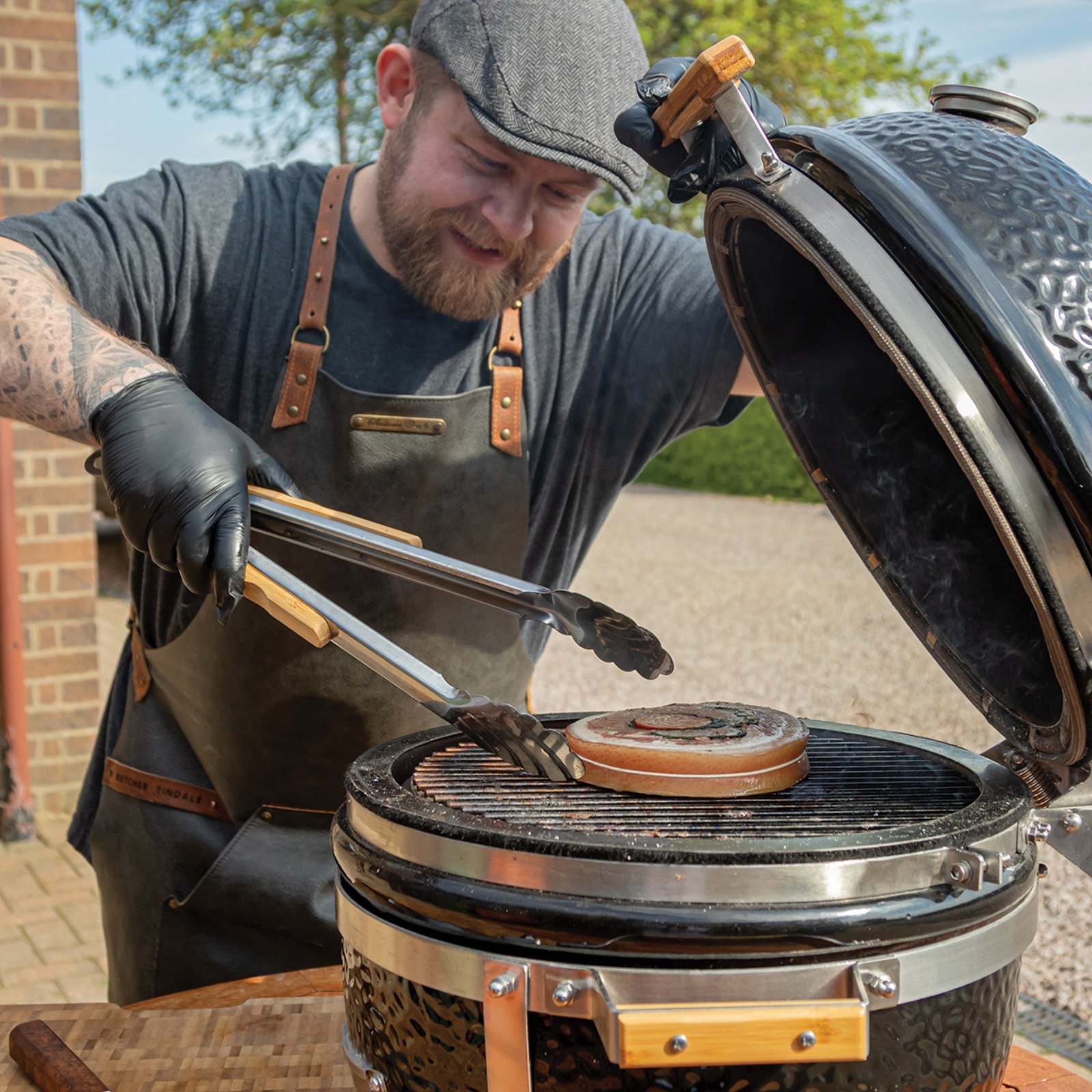Shop Theatre Classroom
The local butcher is a vital cog in the food chain, but the best ones are much more than a place to buy meat. RUPERT BATES listens at the counter
Recipe to save a vital, often misunderstood industry: Take three butchers with a passion for cooking; mix red-hot concern for their trade in a pan of inspiring education, season with lashings of enthusiasm, blend artisan skills with artistic flair – and serve.
Meet Elsie Yardley, Simon Taylor and Ben Tindale. All three represented Team GB at the World Butchers’ Challenge in Sacramento, USA, last year. At the heart of that competition was a desire to raise the global reputation of British butchers and, at the end of the tournament, Team GB captain Simon Taylor, of Surrey Hills Butchers in Oxshott, was appointed captain of an all-star world team. Team GB finished eighth with Germany crowned world champions.
But the real butchery battle lies closer to home on the high streets of UK towns and villages. Before the battle, the back stories, with all three butchers strong advocates of the farm-to-fork ethos, knowing the vital role their profession plays in that journey, but all loving to cook the best of British meat they source, cut, curate and sell, over a barbecue.
“I have always enjoyed cooking from an early age, with memories of standing on a chair helping my dad. I love the artistry too and at college studied art and design. I worked for a local butcher part-time and was captivated by the creativity of the trade and how beautiful everything can look,” says Braintree-raised Elsie Yardley, formerly of Great Garnetts farm near Dunmow in Essex, before recently joining T&G Wholesale Meats in Ascot, Berkshire.
Ben Tindale recalls being coated in flour as a child baking in the kitchen, and his first job aged 14 was in the family restaurant.
“I was involved in catering and food from an early age, before starting work experience with a local butcher and I absolutely love it,” says Tindale, born and bred in south Lincolnshire and working at G. Shearer & Sons butchers in Holbeach.
Taylor began as a butcher’s boy aged 13 in West End, Surrey. “I have wanted to be a chef since I was a child and remember making pies and stews with my nan.”
But this is not about chopping carcasses and breaking bones out the back of the butcher’s shop, while dreaming of donning a fine-dining apron in a Michelin star restaurant.
The trio are all butchers first and foremost, but with craft as well as graft, and at a personal level like nothing more than seeing the meat finish its journey over a BBQ to feed family and friends.
“What I think particularly links the three of us is the performance element of butchery. The love of expressing ourselves in what we create and the displays. If I had gone to college, it would have been to study drama,” says Taylor.
“Of course, there is the practical application of cutting meat and selling it, but without a duty of care we wouldn’t have businesses. A butcher who doesn’t take care and recognise the value of finesse is not a good butcher in my opinion.”
Education is key too. Like any industry, butchery is made up of a variety of characters, some conforming to the crude caricature of the brusque, rotund, ruddy butcher in blood-stained white coat, wanting the money in and the customer out as quickly as possible.
But there are others aware, not just of the need to project their personalities front of house and engage, but appreciating the imperatives of championing both their profession and the provenance of the meat they serve – the animal welfare and ethical supply chain behind the product on the counter and its nutritional value.
Language doesn’t help. The term ‘to butcher’ has been appropriated to mean something done badly or ruined – a failure. Slaughter is another word that many wince at, falsely projecting a vital, skilled, proud profession as some sort of dark art.
But the closure of smaller, local abattoirs, subsumed by centralised systems feeding straight into the big retail markets, is a huge problem for the entire meat industry.
“With the decline of independent slaughterhouses, butchers are going to struggle to fill their fridges and we’re running out of places to go,” says Tindale.
Parochial pathways underpin provenance, as well as connecting food chains and driving sustainable, regenerative agriculture.
“That journey is so important. Customers increasingly want to know where the meat
in our shops comes from. We need those vital local connections between farmers, abattoirs and butchers. Every cog in the chain is as passionate about quality as we are,” says Yardley.
The campaigners are artists too and perhaps the most powerful promotion of their craft is in some of the lavish food displays out there – art galleries of raw meat, with social media imagery driving interest, for we all buy with our eyes.
“You can take a humble topside of beef, but tie and dress it to showcase a stunning raw product – that value add we can offer; but, ultimately, meat that can be practically cooked and enjoyed as a meal,” says Tindale, citing butterflied lamb on an Asado cross as one of his favourite live-fire cooks.
His hospitality experience taught Tindale that restaurant kitchens invariably have barriers, the kitchen unseen by the customer, so no need to worry about theatre, unless putting on a Chef’s Table experience.
“Butchers all have different strengths. But a butcher is both back and front of house. Yes, we work behind the scenes breaking down carcasses, but there is service and showmanship too. There are no places to hide.”
The local butcher is part pub landlord, part village hairdresser – intrinsic to the social fabric of the community, a role highlighted, in the starkest light, by the pandemic lockdowns.
“Regulars come in and the first thing they ask is not what sausages have we got, but about my family, or their holidays – very personal relationships,” says Taylor.
With his increasing profile and expertise as a live-fire chef, and, as with Tindale, an ambassador for the Monolith kamado grill, Taylor enjoys passing on his BBQ knowledge to customers, be it what equipment to buy or what recipes to try.
“In the past I think more people came into the butcher’s shop knowing what they wanted as they knew what they were cooking. The pace of life is so much faster now and you get customers, having suddenly decided on a weekend BBQ, keen to learn quickly what they should buy and how to cook it,” says Taylor, naming a tomahawk steak with dirty cooked onions and chimichurri sauce as one of his favourite BBQ meals.
Tindale highlights the anomaly of more and more ‘information’ available online, translating into less and less knowledge accrued or remembered.
“That’s why the butcher’s role as both purveyor and teacher is so important.”
Good butchers know their customers and, when it comes to BBQ, whether they are adventurers looking for different cuts and to experiment with bold new flavours, or simply after a standard party pack of burgers and sausages.
A queue outside a butcher’s shop, chime all three, is a good thing and the time to slow down, not speed up.
“People also talk in a queue and even share recipes. During lockdown I noticed a lot more younger people coming in and wanting cooking tips,” says Yardley, who loves a hanger steak on a Kamado Joe as her go-to barbecue cut.
“It is very satisfying when a customer walks away confident in what they are going to cook, having had no idea when they walked in.”
BBQ tips and tricks, casual conversation, word-of-mouth endorsement, one-off customers passing through, seasonal shoppers after the Christmas turkey, or village regulars who know your children’s names, it all fundamentally needs to be underpinned by a quality product that transforms into great food – be it cooked outside over coal, gas or wood, or in the indoor oven – meat that crucially won’t let the customer down, especially if catering for a special occasion.
The best barbecues invariably start with the best butchers and they are in short supply, with shops closing as costs rise and supply chains contract. Cherish your local butchers and encourage the next generation to join them.
Yardley says: “We need to inspire young people to enter the industry. There are so many different aspects to the job. Butchery needs to be promoted in schools and colleges. We want kids to say: ‘When I grow up, I’m going to be a butcher.”
Yardley still has to combat sexist surprise that a woman could possibly be a butcher, although, thankfully, attitudes are slowly changing.
“Social media has helped highlight young women coming into our industry. Also farm shops are seeing more and more farmers’ daughters taking on the family business,” says Yardley.
“Having said that, I still get the odd ‘can you get the butcher to cut me some pork chops?’ request in the shop. But I see being a female butcher as an advantage, not a disadvantage, especially when women come in to buy meat and might not feel comfortable asking cooking questions in a predominantly male environment.”
Taylor is cautiously optimistic about the future of his profession, if the right people can get the right messages out.
“People love that image of a bucolic farm beside a beautifully cooked roast dinner – pasture to plate. But we need to highlight the middle of that story and butchers are right in the centre.”
And the best ones are the unsung heroes. It is time to write new chapters and make their voices heard.









